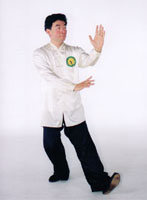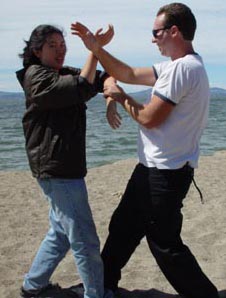
Martial Arts
Taiji: Walking Meditation
Qi Gong
While Qi Gong exercises can often be practiced by oneself, Qi Gong masters can affect the flow of Qi in others, as well.
Kung Fu
Common styles include the Shaolin, Wu Dang, and O-Mei families, of which there are hundreds of sub-categories. Contemporary Wushu, as promoted by Mainland China, is a performance-based style that has less emphasis on combat. However, it helps in the development of explosiveness, speed, agility, and endurance.
While a balanced diet remains one of the most important daily aspects of maintaining good health, physical exercise also contributes toward staying in good shape. Chinese medical theory forms the foundation of many forms of traditional Asian exercises, including Taiji (Tai Chi), Qi Gong (chee gohng), and other forms of Kung Fu.
 Many people are familiar with Taiji: it resembles other Chinese martial arts forms, though it is performed with slow, graceful motions. There are several different families of Taiji, including Chen, Yang, Hao, Wu, Fu, and Sun; however, Yang style stands out as the most widespread. Regardless of the family, all these styles have similar common aspects toward health. The postures involved offer optimal balance of the body, while the movements themselves help promote the flow of Qi. The exercise involves deep breathing and the relaxation of the mind, thereby giving it a meditative quality. Studies have shown that Taiji practice can reduce blood pressure.
Many people are familiar with Taiji: it resembles other Chinese martial arts forms, though it is performed with slow, graceful motions. There are several different families of Taiji, including Chen, Yang, Hao, Wu, Fu, and Sun; however, Yang style stands out as the most widespread. Regardless of the family, all these styles have similar common aspects toward health. The postures involved offer optimal balance of the body, while the movements themselves help promote the flow of Qi. The exercise involves deep breathing and the relaxation of the mind, thereby giving it a meditative quality. Studies have shown that Taiji practice can reduce blood pressure.
Qigong exercises are generally similar to Taiji, though they take many shapes and forms. Regardless of the type of exercise, the goal is to relax the mind and promote the smooth flow of Qi in the body. They involve deep breathing and different kinds of motions. Some versions are considered external, involving larger motions and often combined with striking sand bags or other targets. This category includes Iron Shirt and Iron Hand. Internal approaches, like Taiji, have a soft meditative quality. Popular versions include Wild Goose Qi Gong.
 Generally external in nature, Kung Fu usually involves vigorous movement and exercise, and often incorporates Qi Gong aspects. Kung Fu has its focus rooted in combat; therefore, the movements are not only beneficial to health, but have a self-defense characteristic as well.
Generally external in nature, Kung Fu usually involves vigorous movement and exercise, and often incorporates Qi Gong aspects. Kung Fu has its focus rooted in combat; therefore, the movements are not only beneficial to health, but have a self-defense characteristic as well.
Aren't martial arts and medicine contradictory?
The two aspects are part of a Yin-Yang duality: mutually opposing forces
that complement each other. Through martial arts training, we gain a better
understanding of our body so that we can maintain our own health; through
medical knowledge, we improve the efficacy of our martial arts.
What styles do you teach?
We will be offering Wing Chun Kung Fu
and Yang Taiji. In the future,
we hope to include Contemporary Wushu and other forms of Taiji as well.